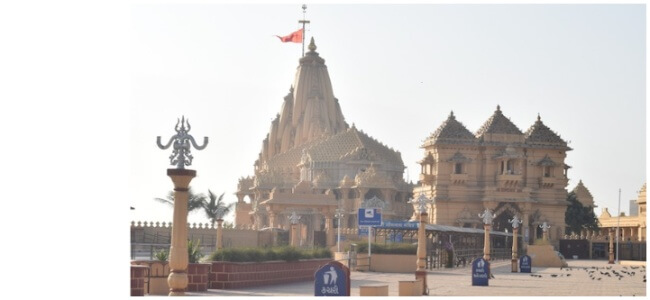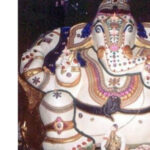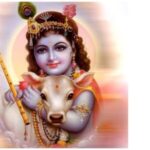The incredible saga of Somnath temple, the first Jyotirlinga Temple in many ways mirrors the saga of India and its people. The great temple remains eternal, rising again and again, every time stronger and more resilient. It is an enduring symbol of Indian culture which has only prospered and flowered against the many attacks that have tried to dent it from time to time.
The story of Somnath, including the legends and myths associated with it as well as its history garnered from various documented accounts, is narrated beautifully by the great Kanhaiyalal Maneklal Munshi ( K.M. Munshi in his book, “Somanatha-The Shrine Eternal.” The book is a must-read for every student of Indian culture and history, in fact, every Indian. In this post, we attempt to give a gist of what the book contains, and the circumstances surrounding its first publication. We recommend reading the book for an immersive experience of the chequered history of Somnath.
Somanatha- The Shrine Eternal

K.M. Munshi dedicates his book, which he aptly titled, “Somanatha – The Eternal Shrine,” to Sardar Vallabhbhai Patel, with these words: “To Sardar Patel, but for whom mine eyes would not have seen the shrine of Somnath rise again.”
The first edition of the book was published in the year 1951, to coincide with the opening of the new Somnath Temple. The rebuilding of the Somnath Temple was spearheaded by Sardar Vallabhbhai Patel, who sadly passed away in December 1950, before the opening of the Somnath Temple. K.M.Munshi, himself was part of the team that was involved in the rebuilding of the temple from scratch and took over the leadership mantle after the demise of Sardar Patel.
This is what K.M.Munshi, says in his preface to the first edition: “On the occasion of the installation of Somanatha, I decided to collect whatever I knew or had done in connection with Somanatha. I am no scholar. The book has been written in great hurry under the stress of pressing preoccupations of a varied nature. I hope, therefore the reader will overlook all shortcomings.”
Of course, this was written in all humility by the great man and writer. The book is an eye-opener for its readers who are not versed with the history of the great temple that stands as an enduring enigma on the shores of the Arabian Sea.
The Saga of Somnath Temple

The saga of the Somnath Temple comes alive in the words of K.M. Munshi, right from its mythological origins to the historical significance of Prabhasa, the Prabhas Patan of today, where the Somnath Temple is located. The book takes you through the fascinating and sometimes chilling, chequered history of the temple, from the history of the first temple to the rising of the Somnath Temple in 1951.
The author also delves into fascinating areas like the growth of the Pashupati cult and how Somnath or Prabhasa was a centre of the same. He also looks at the connection of Dehotsarga and Krishna with Somnath. Dehotsarga which is about 2 kilometres from the Somnath Temple is believed to be the place where the last rites of the mortal remains of Krishna were performed by Arjuna after he was mortally wounded by a hunter’s arrow at Bhalka Tirth, which is about 5 kilometres from the Somnath Temple.
Why was the Somnath Temple at the centre of invading forces? The fact that it was an incredibly rich temple and stood as an icon of the Hindu faith, attracted invaders and marauders from time to time. K.M. Munshi recounts the horrific tales of destruction, and the eulogizing accounts of the beauty and riches of the temple, with equanimity, referring to historical accounts of the time including Muslim chroniclers and inscriptions found at the ancient temple site.
It is my faith in our past which has given me the strength to work in the present and look forward to the future. I cannot value freedom if it deprives us of the Bhagavad Gita or uproots our millions from the faith with which they look upon our temples and thereby, destroys the texture of our lives.
-K.M.Munshi in a letter to Jawaharlal Nehru, the then Prime Minister of India
K.M.Munshi’s Book | Somanatha – The Shrine Eternal | A Gripping Saga of Somnath

The Saga of Somnath as described by the author in the first edition consisted of four parts. Later on in further editions, the publishers added an Appendix titled, “Somanatha Rises Again,” which included additional material, whose author was K.M. Munshi himself.
Part I of Somanatha – The Shrine Eternal, is titled, “The Story of Somanatha,” and consists of 21 chapters and covers the ancient history of not only the temple, but also India, and the religious and cultural ethos of ancient times. It also talks about the construction and subsequent destruction of the temple at different periods in time. It traces the emergence of Mahmud Ghazni, who was one of the chief wreckers and looters of the Somnath Temple, as well as the destruction of the temple by Allaudin Khilji.
Part II of Somanatha – The Shrine Eternal, is titled, “Romance In Stone,” and is made up of 4 chapters, that describe the days of Aurangzeb, and also describe in some detail, what the author calls the First, Second, Third, Fourth, and Fifth temple.
Part III of Somanatha – The Eternal Shrine is titled, “The Temple of Somanatha – History By Excavations and consists of 6 chapters. This section takes a look at the historical background juxtaposed against different excavations and their finding. It tries to piece together a chronology of the original temple, based on this.
Part IV of Somanatha – The Shrine Eternal is titled, “Muslim Chroniclers on Somanatha Inscriptions.” It delves into the accounts of various Muslim chroniclers, including the ones during the time of Mahmud Ghazni, and Allaudin Khilji, who have given a graphic account of the grandeur of Somnath and also its destruction. The chronicles are of the likes of Al-Biruni, and Farrukhi. It is worthwhile to mention that Al-Biruni accompanied Mahmud Ghazni during his invasion of India.
This is a humble attempt to bring to the notice of people at large the great literary work of K.M. Munshi which outlines the saga of the Somnath Temple. If even a single person were to read the book, Somanatha-The Shrine Eternal, the purpose of this post would be deemed to have been achieved.
Do subscribe to our blog for more interesting content, and follow us on Twitter, and Instagram.

Thanks for visiting our site nirvandiaries.com and taking the time to read this post.
If you wish to collaborate or work with us then reach us at [email protected]
We’d love it if you’d comment by sharing your thoughts on this post and share this post on social media and with your friends.
Follow our journey on our social media channels:
Facebook Twitter Instagram Pinterest YouTube






